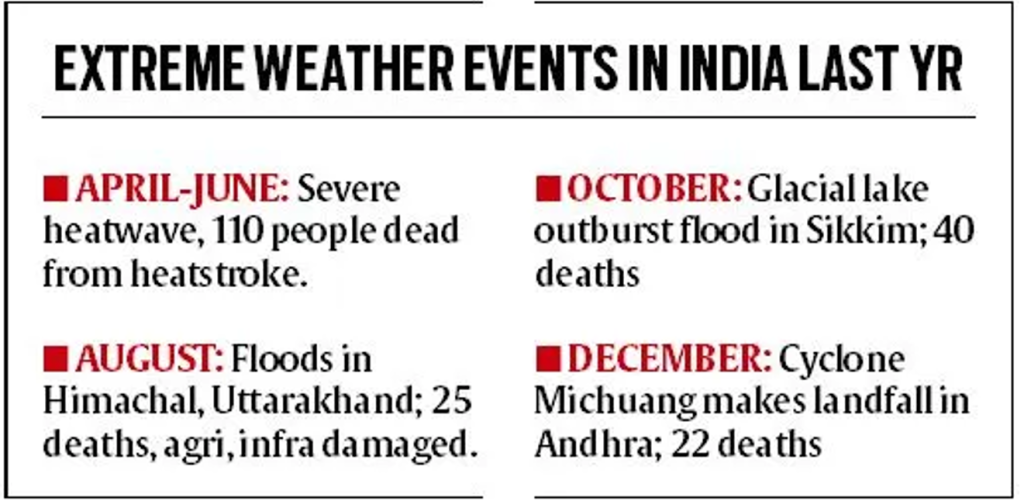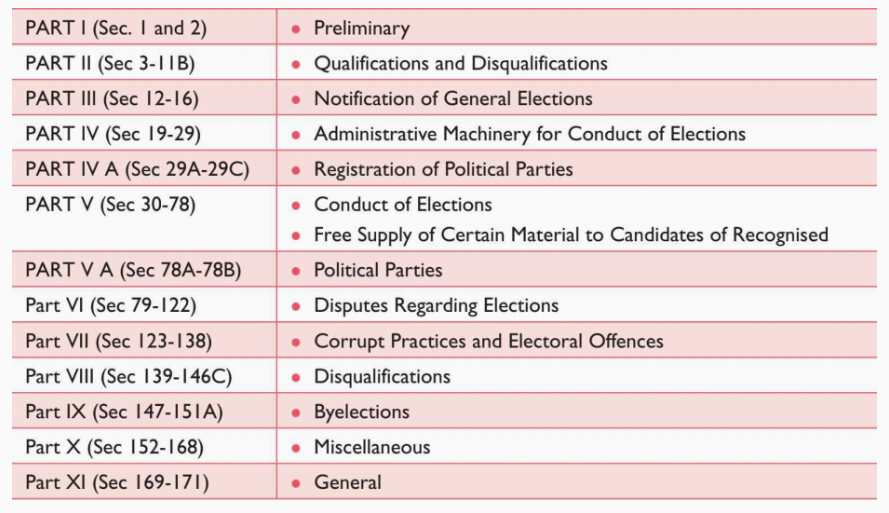CONTENTS
- ‘State of the Climate in Asia’ Report, 2023
- When is a Candidate Elected Unopposed?
‘State of the Climate in Asia’ Report, 2023
Context:
According to the World Meteorological Organization’s 2023 ‘State of the Climate in Asia’ report, Asia has experienced a more rapid warming trend compared to the global average since 1960. The report highlighted that 2023 marked the warmest year on record worldwide. Additionally, it pointed out a concerning disparity between climate forecasts and the capacity of Asian nations to adapt to and mitigate the effects of climate change.
Relevance:
GS1- Important Geophysical Phenomena
GS-3
- Environmental Pollution and Degradation
- Conservation
Mains Question:
What does the 2023 ‘State of the Climate in Asia’ report say about the capacity of Asian nations to adapt to and mitigate the effects of climate change? Where does India stand in these findings and what can be done by India as a country and South Asia as a region to mitigate these effects? (15 Marks, 250 Words).
Impact of the Increased Temperatures in Asia:
In 2023, over 2,000 fatalities and more than nine million individuals were affected by extreme weather events across the continent. Approximately 80% of these incidents were attributed to storms and floods.
Heatwaves:
- The report also documented severe heatwaves in various regions, resulting in numerous deaths. However, it acknowledged that the actual number of heat-related casualties is likely higher due to underreporting.
- For instance, in India, approximately 110 people lost their lives due to severe heatwaves in April and June. A prolonged heatwave gripped extensive areas of South and Southeast Asia during April and May, affecting regions ranging from Bangladesh and eastern India to southern China.

Floods and Storms:
- The most potent cyclone to hit the Bay of Bengal in the past ten years, Tropical Cyclone Mocha, struck Myanmar and Bangladesh in May 2023.
- Subsequently, floods, landslides, and lightning claimed the lives of approximately 600 individuals across India, Pakistan, and Nepal in June and July of the same year.
- Floods and landslides in August 2023, mainly in Himachal Pradesh and Uttarakhand, resulted in at least 25 fatalities in India.
- Lightning strikes were responsible for 1,200 deaths across India throughout the year.
How Effective are Asia’s Disaster Warning Systems?
- An early-warning system encompasses a comprehensive process involving monitoring, prediction, and forecasting of hazards, along with risk assessment, communication, and preparedness activities. These systems enable timely action by individuals, communities, governments, and businesses to mitigate risks.
- Thanks to such systems, authorities in Bangladesh had a day’s advance notice to prepare for Cyclone Mocha and undertake preventive measures in Cox’s Bazar, enhancing the survival chances of local communities during its landfall.
- Twenty-one Asian countries reported the status of their early warning systems to the UN. According to the UN Office for Disaster Risk Reduction, the average composite scores for the availability of and access to multi-hazard early warning systems, preparedness to respond, and observation and forecasting in Asia were 0.46, 0.58, and 0.50 out of 1, respectively. In comparison, the global averages were 0.35, 0.78, and 0.33, respectively.
- Warning and dissemination emerged as the strongest aspect of the framework for Asia, while risk knowledge appeared as the weakest. The report also highlighted that fewer than half of all Asian countries possess the necessary tools to mitigate the impacts of climate change.
What Implications do these Findings Hold for India?
- A scientist at the India Meteorological Department in Pune and a lead author of the State of the Climate in Asia report, emphasized that the report’s conclusions align with their agency’s analysis. He highlighted the global trend of increasing extreme climate events, including in India.
- However, he expressed optimism that with enhanced preparedness, the damage from such events can be minimized.
- He cited the example of using early warnings during Cyclone Mocha, a severe cyclone in the Bay of Bengal, to mitigate its impact, noting that similar cyclones in the past had resulted in significant casualties.
- While acknowledging India’s improved preparedness for cyclones, he underscored the need for better management of deaths and destruction caused by lightning.
- He mentioned challenges faced by marginalized communities in accessing warning tools, particularly those like farmers who may be away from information sources when alerts are issued.
- The Global Engagement Director at the Fossil Fuel Treaty Initiative, commended India’s historical resilience in facing floods, storms, and droughts but warned that the country’s preparedness is significantly inadequate to address the escalating challenges posed by climate change.
Conclusion:
New threats such as unprecedented heatwaves, glacier retreat, and rising sea levels, highlight the urgent need for a strategic overhaul of current policies and adaptation strategies. The importance of empowering communities with resources and policies to effectively combat these evolving climatic adversities is of extreme importance today.
When is a Candidate Elected Unopposed?
Context:
On April 22, the Bharatiya Janata Party (BJP) secured its first seat in the Lok Sabha as its candidate, was elected unopposed for the Surat constituency in Gujarat, the state’s western region. This occurred after the rejection of the Congress candidates’ nomination papers, both primary and substitute, on the previous day, along with the withdrawal of other candidates. Consequently, Surat, Gujarat’s second-largest city, will not participate in polling on May 7.
Relevance:
GS2- Electoral System
Mains Question:
What are the provisions under the Representation of the People Act, 1951 that allowed a candidate to be elected unopposed in the Surat constituency in Gujarat as seen recently? Also analyse how does the Rule 49-O of the Conduct of Election Rules, 1961 and NOTA differ in their operation? (15 Marks, 250 Words).
How is a Candidate Declared Elected Without Polling?
- The procedure for uncontested elections is outlined in Section 53(3) of the Representation of the People Act, 1951. According to this provision, if the number of candidates is fewer than the seats to be filled, the returning officer (RO) must promptly declare all such candidates elected.
- The RO’s actions in this regard are governed by Section 33 of the Act, which addresses the presentation of nomination papers and the requirements for a valid nomination.
- Sub-section 4 of Section 33 states: “Upon the presentation of a nomination paper, the returning officer must ensure that the names and electoral roll numbers of the candidate and their proposer, as listed in the nomination paper, match those in the electoral rolls…”
- In the specific case mentioned, three proposers of the Congress candidate for Surat stated in an affidavit to the district election officer (DEO) that they had not signed his nomination form. Additionally, they failed to appear before the DEO on April 21 to endorse the candidate’s nomination form.

- Furthermore, the Handbook for Returning Officers (Edition 2), issued by the Election Commission (EC) in August 2023, contains a chapter dedicated to uncontested elections. It specifies that if a constituency has only one candidate contesting, that candidate should be declared duly elected immediately after the deadline for withdrawal of candidature. In such a scenario, conducting a poll is unnecessary.
- Additionally, the handbook mandates that candidates returned uncontested, especially those with criminal backgrounds, must publicize their details in the prescribed format within the specified timeline.
What options exist for expressing disapproval within the election system?
- There are several avenues within the system for expressing disapproval. While the NOTA (none of the above) option has been available since 2013, Rule 49-O of the Conduct of Election Rules, 1961, allows electors to abstain from voting.
- In this case, the presiding officer must note in the “remarks column” of the Register of Voters that the elector has chosen not to cast their vote, followed by obtaining the elector’s signature or thumb impression against this remark.
- The introduction of the NOTA option, mandated by the Supreme Court’s intervention, has been implemented on electronic voting machines (EVMs) since November 2013.
- This decision came following a verdict by a Supreme Court Bench led by Chief Justice P. Sathasivam and Justices Ranjana Desai and Ranjan Gogoi in September 2013, in response to a petition filed by the People’s Union for Civil Liberties.
- The Chief Justice, who authored the judgment, emphasized the importance of granting voters the right to express disapproval while safeguarding their secrecy.
- He expressed optimism that this option would drive systemic change, compelling political parties to nominate candidates known for their integrity, thereby aligning with the will of the people.
Difference between Rule 49-O and NOTA:
- In the former case, the possibility of compromising secrecy is higher as the elector must follow a manual procedure at the polling booth. Conversely, in the latter scenario, this concern does not arise.
- However, according to the Handbook for Returning Officers (ROs), NOTA votes are not considered when calculating the total valid votes cast for determining the return of the security deposit.
- The Election Commission (EC) maintains that the candidate receiving the highest number of votes in any constituency will still be declared the winner, irrespective of the number of NOTA votes.
- However, the situation differs for local body elections, particularly in Maharashtra. In November 2018, the Maharashtra State Election Commission issued an order stating that NOTA would be treated as a fictional electoral candidate for urban local body polls. In instances where NOTA receives the highest votes, the Commission would opt for a re-poll.
What have been the Developments following the Implementation of NOTA?
- There have been occasions where the number of votes garnered by political parties was lower than the count of NOTA votes. However, a segment of activists and constitutional experts has criticized NOTA, labeling it a “toothless tiger” with no bearing on the election results.
- This is despite NOTA accumulating over 1.29 crore votes in the combined State Assembly and Lok Sabha elections over the past five years.
- On April 26, the Supreme Court, which had previously declined to compel the Election Commission (EC) to conduct fresh polls if a majority of voters opted for NOTA, directed the poll panel to respond to a petition requesting new elections in constituencies where NOTA votes outweighed those for any candidate.
- The petitioner, author Shiv Khera, sought the court’s intervention to instruct the EC to establish rules specifying that candidates receiving fewer votes than NOTA should be disqualified.
Conclusion:
It is vital to maintain fairness and transparency in India’s electoral process to uphold democratic ideals. When candidates win seats without opposition, it undermines this goal. India can achieve elections free from malpractice and manipulation through strong legal frameworks, institutions, and citizen involvement. Collaboration among political parties, electoral bodies, and the judiciary is crucial in preserving the integrity of the electoral system.





